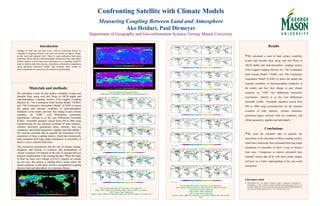NY
The researchers calculated land surface variability metrics and land-atmosphere coupling metrics for the Community Earth System Model (CESM1) and Community Atmosphere Model (CAM5) using data from the Last Millennium Ensemble (LME) to assess spatial and seasonal variability of land-atmosphere feedbacks in the models and how they change in past climate scenarios. They hypothesize that land use practices will impact the rate of climate change, extremes, and predictability. The ensemble data was used to quantify uncertainty in coupling metric calculations, which have typically been estimated from single long simulations or short ensembles. Comparison to metrics calculated from remote sensing data will provide understanding of real-world mechanisms.

Recommended
Recommended
More Related Content
What's hot
What's hot (20)
Similar to NY
Similar to NY (20)
NY
- 1. Materials and methods: We calculated a suite of land surface variability (Latent and Sensible Heat, along with Soil Water in 10CM depth) and land-atmosphere coupling metrics (Two-Legged Coupling Metrics) for “The Community Earth System Model” CESM1, and “The Community Atmosphere Model” (CAM5) to assess the spatial and seasonal variability of land-atmosphere feedbacks in the model, and how they change in past climate scenarios via “LME”. Last Millennium community experiments, referred to as the Last Millennium Ensemble (LME). “Ensemble members extend from 850 to 2006 using reconstructions for the transient evolution of solar intensity, volcanic emissions, greenhouse gases, aerosols, land use conditions, and orbital parameters, together and individually.” We used the ensemble data to quantify the uncertainty in the calculation of these coupling metrics, which have historically been estimated from long single simulations or ensembles of short (1-year or shorter) hind casts. The researchers hypothesize that the rate of climate change, frequency and severity of extremes, and predictability of climate variations will depend on the type of regional land use practices implemented in the coming decades. While the study of land use land cover change (LULCC) impacts on climate are not new, this project is starting from a point where the model consensus is that there will be a strengthened coupling between land and atmosphere in a warming climate. Results We calculated a suite of land surface variability (Latent and Sensible Heat, along with Soil Water in 10CM depth) and land-atmosphere coupling metrics (Two-Legged Coupling Metrics) for “The Community Earth System Model” CESM1, and “The Community Atmosphere Model” (CAM5) to assess the spatial and seasonal variability of land-atmosphere feedbacks in the model, and how they change in past climate scenarios via “LME”. Last Millennium community experiments, referred to as the Last Millennium Ensemble (LME). “Ensemble members extend from 850 to 2006 using reconstructions for the transient evolution of solar intensity, volcanic emissions, greenhouse gases, aerosols, land use conditions, and orbital parameters, together and individually.” Conclusions We used the ensemble data to quantify the uncertainty in the calculation of these coupling metrics, which have historically been estimated from long single simulations or ensembles of short (1-year or shorter) hind casts. Comparison to metrics calculated from remotely sensed data (R.S) with these model outputs will give us a better understanding of the real world mechanism. Confronting Satellite with Climate Models Measuring Coupling Between Land and Atmosphere Ako Heidari, Paul Dirmeyer Department of Geography and Geo-information Science, George Mason University Literature cited Otto-Bliesner, B.L., E.C. Brady, J. Fasullo, A. Jahn, L. Landrum, S. Stevenson, N. Rosenbloom, A. Mai, G. Strand. Climate Variability and Change since 850 C.E.: An Ensemble Approach with the Community Earth System Model (CESM), Bulletin of the American Meteorological Society, 735-754 (May 2016 issue) Introduction Changes in land use and land cover, such as converting forests to cropland or irrigating formerly dry areas, are known to impact climate on the local and regional level. There is some indication from prior modeling studies that the land-atmosphere interactions that cause these climate impacts will become more pronounced in a warming world. In order to further study this concept, researchers will perform simulations using advanced numerical models and compare those results to observational data to assess how the models are performing. Fig. 3 Comparing the Impact of Land Use Land Cover Change on the Coupling between Land and Atmosphere vs. Control Run, 10th & 20th Century. Fig. 1 Terrestrial and Atmospheric Fluxes: 1)Soil Water in 10CM Depth 2)Latent Heat Flux 3)Sensible Heat Flux Fig. 2Comparing the effect of Control Run vs. one single force 1)10th Century, Impact of Control Run minus Land Use Land Cover Change 2)20th Century, Same Comparison 3)Same Century, Different Comparison: Impact of Control Run minus Green House Gas Fig. 3Comparing the effect of All Forces vs. one single force 1)10th Century, Impact of All Forces minus Land Use Land Cover Change 2)15th Century, Same Comparison 3)18th Century, Same Comparison 4)19th Century, Same Comparison 5)Same Century, Different Comparison: Latent Heat Coupling rather than Sensible Heat
